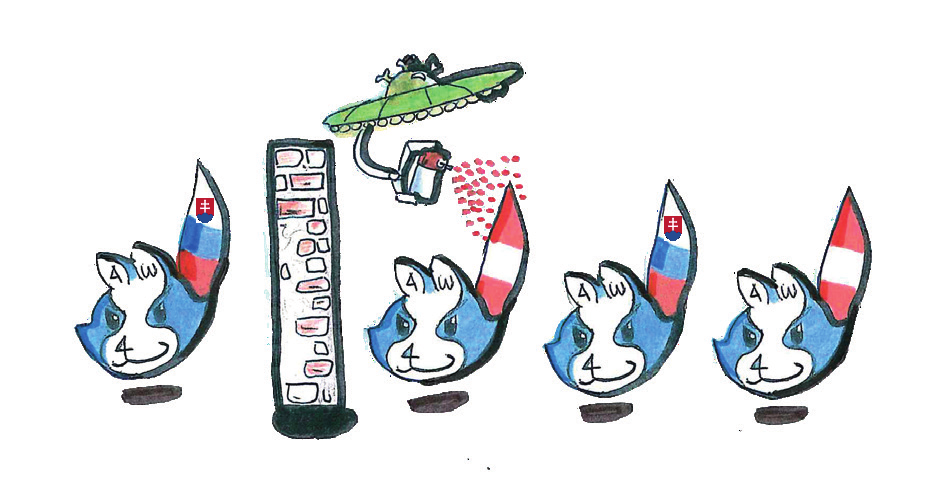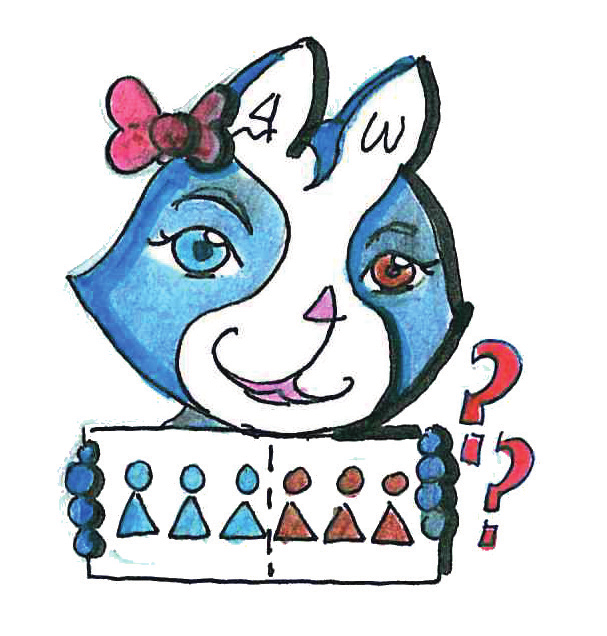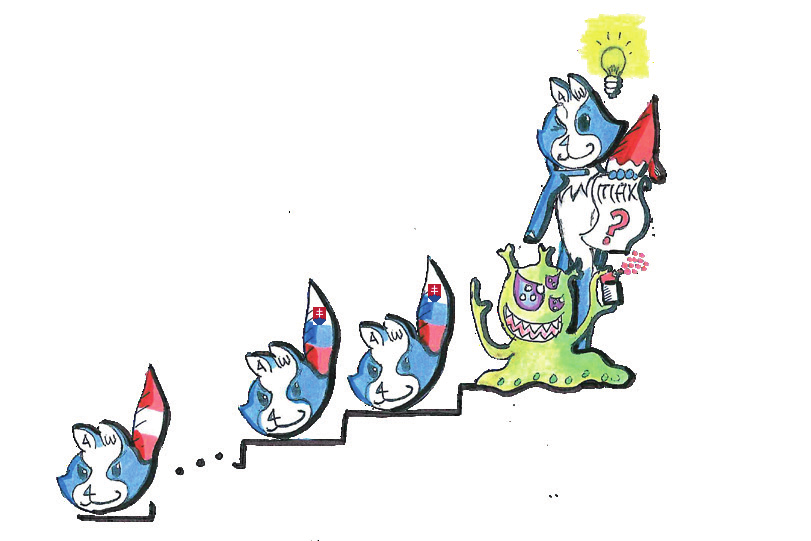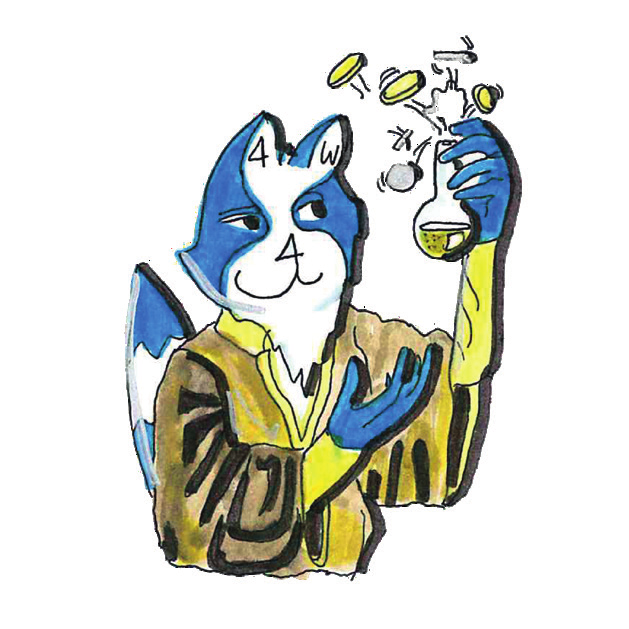Episode 2
Challenge #1 "The Riddle"

A warm-up exercise to get started. Find the corresponding words.
Each line represents some letters. Hint: It might be a good idea to think out of the (mathematical) box :)
SOLUTION: Forum MathematiQum
Proof:
The three rows give the following: Forum: o [IV – u] = Four – u = For o u o [10^-3]=m (milli) maTheMati: o F is the symbol for force, and force can be written as mass times acceleration hence F=ma (Newton's second law of motion) o 10^12 is Tera hence this translates to To E/f = h (Planck's constant) o 2,718… indicates e, Euler’s number o 10^6 = M (for Mega) o @ = ato √-1 = i QuM o What we see on the picture is the rational numbers in purple, so this is Q o The blue set is called M o They have an intersection, but in the end one is interested in the union of both, so therefore this is QuM. All together this gives the solution (not case sensitive). The solution is also the name of a facebook and a LinkedIn group. Coincidental? Find out! :-)
Challenge 2 “Logic RaQoon”

There are four raQoons lined up as showed below. There is a wall in-between raQoon 1 and raQoon 2. RaQoon 3 is standing behind raQoon 2, and raQoon 4 is standing behind raQoon 3.
The tails of the raQoons will be dyed either in Austrian or Slovak colors.
Every raQoon is looking in the direction of the wall and can see therefore raQoons tails in front of it (raQoon 4 sees the tails of raQoon 2 and 3), but no one can look over the wall. No raQoon sees its own tail.
The raQoons (which are hilarious logicians by the way) are told, that:
- There are two raQoons which have Slovak dyed tails, and two raQoons with Austrian dyed tails
- The raQoon which is 100% sure which color its tail has, can call out and earn a cookie. No guessing allowed!
Which of the raQoons will be the lucky one to receive a cookie after a while?
SOLUTION: RaQoon 3
Proof:
- RaQoon 4 sees raQoon 2 and raQoon 3. If raQoon 2 and raQoon 3 had the same colors, raQoon 4 would call out immediately to receive a cookie.But it didn’t.
- So raQoon 3 notices that raQoon 4 is silent, which implies that raQoon 2 and itself have differently dyed tails. The tail of raQoons 2 is dyed in Austrian color, so raQoon 3 knows that its tail has Slovak colors.
Want to discuss this? This is the right place for it: facebook and a LinkedIn group :-).
Challenge #3 "Smart weighting"

If you have two wheels of the same size, one of which is heavier than the other, you can simply find out which one is heavier. You just place them on the opposite bowls of isosceles weight.If you have four wheels and one of them is heavier than the others, you can find out which one it is by using two weightings.
Suppose, a raQoon has 15 identical wheels and the 16th one is of the same size, but heavier. How many weightings does a raQoon need for sure to find out which wheel is extra?And do not forget: raQoons do not rely on luck and are extraordinarily logical ;-)
SOLUTION: 3
Recipe:
• 1st weighting
Divide the 16 wheels into three groups of 5, 5 and 6.We compare 5 to 5.If the scales have swung to a side, you know a heavier wheel is in the corresponding group.If the scales have not swung to a side, then there is a heavier wheel in the remaining third group of 6.
• 2nd weighting
Divide the 5 (or 6) wheels into three groups of 2,2 and 1 (or 2,2, and 2).We compare 2 to 2.If the scales have swung to a side, you know a heavier wheel is in the corresponding group.If the scales have not swung to a side, you have found the heavier wheel (or a heavier wheel is in the remaining third group of 2)
• 3rd weighting
We compare remaining two wheels and you find the heavier wheel.
You have found a different solution? Let’s discuss it here: facebook or LinkedIn :-)
Challenge #4 "Blue-eyed sisters"

If you meet two raQoon sisters of the UNIQA 4WARD family (here we assume that the two sisters are randomly selected from a set of all UNIQA 4WARD sisters), the probability of both being blue-eyed is exactly a half.
What is your best estimate of the number of UNIQA 4WARD raQoon sisters? How many of them are blue-eyed?
Hint: The UNIQA 4WARD family is growing steadily but it is not that huge. Therefore, we are looking for the smallest possible solution.
Please give your answer in the following way: “?? out of ??” (are blue-eyed).
SOLUTION: 3 out of 4
Proof:
Let’s consider:
n - number of all sisters
b - number of blue-eyed sisters (b<n or b=n)
The probability that two randomly chosen sisters are blue-eyed is:
[b/n] * [(b-1)/(n-1)]
The problem is to find integers b and n such that the above formula equals 1/2.
The smallest possible solution is n = 4, b = 3.
(Another possible solution is n = 21 and b = 15, but we were looking for the smallest possible solution.)
So the best estimate is that 3 out of 4 sisters are blue-eyed.You found an even shorter way how to solve this? Let us know: facebook and a LinkedIn :-).
Challenge #5 "Logic raQoons – Part II"

Oh no! Thirteen of our raQoons get caught by aliens!
The aliens are kind of evil (you can see it in their eyes) and therefore are playing the following “game” with the raQoons:
- The raQoons must stand in a queue, the order is random.
- No raQoon is permitted to turn its head. This means, each raQoon sees only theraQoons in front of it (all in front of it).
- The aliens dye the tails of the raQoons, either in Slovak or Austrian color
- Every raQoon must tell the color of its own tail, beginning by the last one in thequeue (i.e. the raQoon which sees all other twelve raQoons in front of it). So, the orderis from right to left in the picture below.
- A raQoon is set free if it says the correct color of its own tail, otherwise the raQoonhas to go with the aliens to another universe. Every raQoon in a queue can hear if other raQoons were wrong or right.
The aliens give the raQoon a chance to align a strategy before the game starts.
And they do so. By using a perfect strategy, what is the maximum number of raQoons which can be rescued for sure?
And don’t forget: raQoons are extraordinarily logical ;-)
SOLUTION: 12 Racoons
Proof:
The strategy is that the last Racoon will count the number of Austrian flags.
- If the number is odd he will say “Austrian Flag”.
- If the number is even he will say “Slovak Flag”.
Every other Raccoon knows now if the number of Austrian flags is odd or even.
Now he can
- count for himself the numbers of Austrian flags before
- count the number of Racoons saying “Austrian Flag” behind him (except the last Racoon in the queue)
He ends up with an odd or even number and if it matches to the information from the last Racoon he has a Slovak Flag – otherwise he has an Austrian Flag.
Challenge #6 "Numbers"

Let’s take a large number. N0 = 2012! (= 2012*2011*...*2*1). Calculate N0.
Now, by calculating the sum of the digits of N0 you get a new number N1.
Again, calculate the sum of the digits of N1 and get a new number N2.
Again, calculate the sum of the digits of N2 and get a new number N3.
Proceed with this procedure until you end up with a single digit number. Which one?
SOLUTION: 9
Proof:
- Please note that from the definition of the factorial:
- N0 = 2012! (= 2012*2011*…*2*1).
- Observation 1: From the fundamental theorem of arithmetic we know that every integer greater than 1 either is a prime number itself or can be represented as the product of prime numbers.
- Therefore, we state that the number 2012! needs to divisible by 9. Alternatively, we can deduce it from the definition of factorial.
- Observation 2.1: An integer n > 0 is divisible by 9 if and only if, the sum of its digits in its decimal expansion is divisible by 9. Proof can be found here: Apostol (1976), p. 108 .
- Observation 2.2: Note that for large numbers this rule (Observation 2.1) can be applied again to the result.
- From Observation 1 we deduce that 2012! is divisible by 9. Using Observation 2.1 and Observation 2.2 we observe that when applying following procedure:
- Calculate N0.
- Now, by calculating the sum of the digits of N0 you get a new number N1.
- Again, calculate the sum of the digits of N1 and get a new number N2.
- Again, calculate the sum of the digits of N2 and get a new number N3.
- Proceed with this procedure until you end up with a single digit number.
- we obtain 9, as a single digit number.
This was to easy? Let us know if you have similar but harder riddles: facebook or LinkedIn ;-)
Challenge #7 "The money making raQoon"

A raQoon has figured out how he can earn gold out of silver and so it can grow a treasure over time. The growth procedure is as follows:
- The raQoon starts with one piece of silver.
- On the first day, the silver piece is turned into a gold piece.
- On each successive day, each silver piece from the previous day is turned into agold piece, and each gold piece from the previous day into two pieces, one silver and one gold.
So, at the end of day 1, the raQoon has 1 gold piece; at the end of day 2, the raQoon has 1 gold piece and 1 silver piece; at the end of day 3, the raQoon has 2 gold pieces and 1 silver piece.
Each silver piece is worth 1 RAQ; each gold piece is worth Q:= (1+√5)/2 RAQ.
Now the raQoon is interested how to describe this growth mathematically. Help the raQoon and give a closed form formula (depending on Q and n) for the value of the treasure after day n.
SOLUTION: Q^n
Proof:
- From the challenge we know that:
- The raQoon starts with one piece of silver.
- On the first day, the silver piece is turned into a gold piece.
- On each successive day, each silver piece from the previous day is turned into a gold piece, and each gold piece from the previous day into two pieces, one silver and one gold.
- Each silver piece is worth 1 RAQ; each gold piece is worth Q:=(1+√5)/2 RAQ.
- Example: at the end of day 1, the raQoon has 1 gold piece; at the end of day 2, the raQoon has 1 gold piece and 1 silver piece; at the end of day 3, the raQoon has 2 gold pieces and 1 silver piece.
- Let’s assume that “s” is the number of silver pieces that the raQoon has at the beginning of the day and “g” is the number of the gold pieces.
- Therefore, at the beginning of each day the value of the raQoon’s treasure equals
- s+ Q g RAQ. (Eq. 1)
- Please note that on purpose we do not state what s and g values are here.
- Therefore, at the beginning of each day the value of the raQoon’s treasure equals
- At the end of the day silver turns into gold and each gold piece from the previous day into two pieces, one silver and one gold, so we obtain
- g+ Q(s+g)=Q s+ g(1+Q) RAQ. (Eq. 2)
- Again, please note that on purpose we do not state what s and g values are here.
- The question is how to describe this growth mathematically between day n and n+1.
- Please note following property of phi function:
- Q^2=Q+1
- Proof:
- Q^2=((1+√5)/2)^2=(6+2√5)/4=(1+√5)/2+1= Q+1
- Now, in (Eq.2) we can substitute the above result:
- Q s+ g(1+Q) RAQ= Q s+Q^2 g RAQ. (Eq.3)
- Comparing (Eq.1) and (Eq.3), the difference between day n and day n+1 we observe that the growth of the treasure raQoon has equals:
- Q^(n+1)= Q^n*Q (Eq.4).
- To formally end the proof, we need to wrap what we did in induction.
- For day 1 it is correct, as at the end of the day we have 1 gold piece that is worth Q RAQ.
- For day k it is correct as we showed in (Eq.4).
- This finalizes the proof. (Eq.4).
- Q^2=Q+1
Want to discuss this? This is the right place for it: facebook or LinkedIn group. :-)
